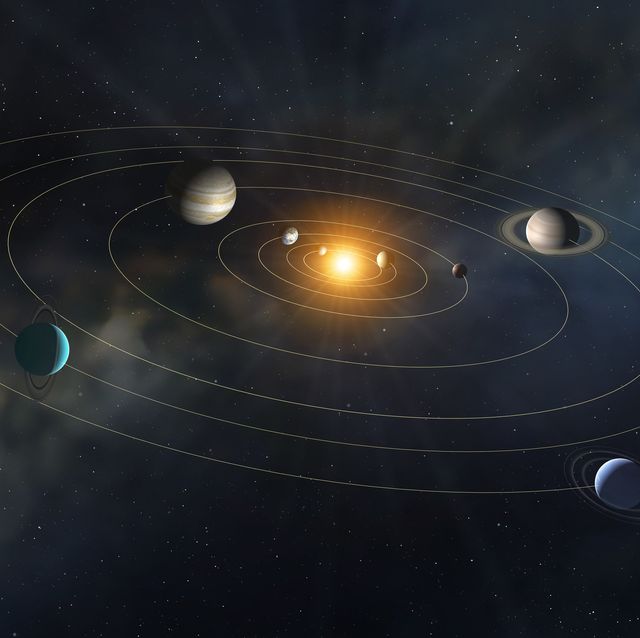The night sky may appear like an inky black canvas, but astronomers are still attempting to answer the questions: “how dark can the night sky get?” and “will there be any light leftover after that?”
It’s not exactly possible, or advisable, to go across the cosmos turning out the lights in the form of the sun, other stars, or distant galaxies, so a team of researchers did the next best thing.
They went through a whopping 200,000 images collected by the Hubble Space Telescope (HST), systematically making measurements to account for the light from our solar system in order to hunt for any background glow that remains and is thus from an unknown source. The work was carried out as part of an initiative called “SKYSURF.”
In accounting for the light emanating from stars and galaxies, reflected by planets and moons, and even emitted by glowing dust in the plane of our solar system, they found something spooky. A tiny amount of light—equivalent to the steady glow of 10 fireflies — remained, spread out across the entire sky from our view on Earth.
“Looking at data from the HST, we found that the level of background light was higher than expected,” team member and Arizona State University postdoctoral researcher Tim Carleton told Popular Mechanics. “Images taken with HST are very sensitive to things like stars and galaxies; by looking between all the stars and galaxies, and subtracting known diffuse—spread-out—sources of light from the solar system and the Milky Way, we could see if there was any extra source of light that hadn’t been accounted for yet. And we think we found some!”
The discovery is similar to turning out all the lights in your room, drawing the curtains, shuttering the windows, and still observing a ghostly glow filling the room.
Carleton offers another colorful analogy for the discovery, documented in three papers published in The Astronomical Journal and The Astrophysical Journal Letters.
“I think of it in terms of accounting,” the researcher said.“You have $100 in sales; $75 is from the solar system, $10 is from the Milky Way, $8 is from other galaxies, but you don’t know where the remaining $7 comes from.”
“Ghost hunting” in the solar system
The idea to go searching for this “ghost light” came from Arizona State University professor and veteran astronomer Rogier Windhorst. He was inspired by the fact that 95 percent of the photons, the fundamental particles of light, in HST archival images originate from distances less than 3 billion miles from Earth. Many astronomers using the HST since its launch in 1990 have discarded these photons because they are only interested in using the telescope to examine faint light from very distant objects.
Windhorst wanted to focus on these oft-ignored “sky photons,” believing that they offer important information about the cosmos that could be extracted by the power of HST to measure faint brightness levels to high precision.
This wasn’t the original purpose of the SKYSURF project, which initially set out to understand the cosmic extragalactic background light radiation that accumulated in the universe over time as a result of star formation processes and from contributions from active galactic nuclei.
“There has been some discrepancy recently in the total amount of extragalactic background light. If we have observed and accounted for all types of galaxies in the Universe, the total amount of extragalactic background light should be equal to the total amount of light from all galaxies,” Carleton said. “Yet, the direct measurements of the total level of extragalactic background light are higher than what you would expect if you added up all the light from all the observed galaxies, suggesting that we are missing a population of galaxies.”
Carleton came aboard SKYSURF to investigate this problem and was taken aback by the discovery of this solar system ghost light.
“These results were pretty surprising to me!” Carleton said. “I came at this experiment from more of a ‘trying to understand if there are extra galaxies’ perspective, so I was surprised that the analysis suggested a source of light closer to home.”
Not to worry though; there’s definitely a scientific explanation for this eerie leftover glow. The team may have been surprised by this spooky solar system glow, but they have a few ideas about its origins.
The solar system’s “ghostly glow” is unexplainable… for now
One potential source for the SKYSURF glow is a shell of dust left within the inner solar system by comets falling into the solar system from random directions. The glow is explained by sunlight reflecting from this shell.
“The possibility that I think is most likely is that it comes from dust left behind from comets in the solar system,” Carleton said. “We are currently studying a wider range of wavelengths to see if those measurements would be consistent with a cometary dust model.”
If this is the case, it means by discovering this shell of dust the team has found a completely hitherto-unknown element of the architecture of our solar system. Carleton added: “We think we have explored the solar system so much, but there is still so much to understand!”
One lingering question is: how can the SKYSURF team be sure that this ghostly glow is actually coming from within the solar system and not coming from an outside source? The answer actually comes from the fact that this actually isn’t the first time astronomers have caught a ghost light.
In 2021, a completely different set of astronomers using observations collected by NASA’s New Horizons spacecraft also found a strange unaccounted-for, leftover light in the solar system. This data was collected after New Horizons had flown past Pluto in 2015 and the Kuiper Belt of comets at the edge of the solar system in 2018, so the craft was well on its way to interstellar space.
That means the much fainter New Horizons glow, which remains unexplained, was spotted from a distance of 4 to 5 billion miles from the sun and well away from the solar system’s planets and asteroids where there is no contamination from interplanetary dust.
“New Horizons was pretty much outside the solar system when they found their glow, so it is not likely to be coming from dust within our solar system — it might be coming from the Milky Way,” Carleton said, “but seems to really be coming from galaxies or some other light source outside the Milky Way.”
The researcher explained that the main reason the team can tell the SKYSURF glow comes from within the solar system is actually related to the New Horizons result.
“They found a significantly lower level of light than we did, so most of the light is probably coming from between us and them,” Carleton continued. “Also, HST is very sensitive to things outside the solar system like stars and galaxies, so we don’t think faint galaxies could account for the level of light that we see.”
The investigation of the SKYSURF glow continues, as does the SKYSURF project itself. Carleton explained that the researchers are now looking at the glow in additional wavelengths of light to see what this reveals.
“This initial analysis was just looking at a couple of wavelengths in infrared where we expected our results to be most significant,” he said. “Our team is working on a much broader analysis that will study wavelengths from ultraviolet to infrared.”
Robert Lea is a freelance science journalist focusing on space, astronomy, and physics. Rob’s articles have been published in Newsweek, Space, Live Science, Astronomy magazine and New Scientist. He lives in the North West of England with too many cats and comic books.














